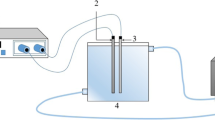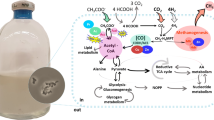Abstract
The effect of heavy metal (HM) (Cu(II), Fe(III), Ni(II), Zn(II)) salts on propylene oxidation by the methane-oxidizing bacteria Methylococcus capsulatus (M) as a process simulating methane oxidation by methanotrophic bacteria is investigated. The reaction begins with the activation of molecular oxygen with subsequent polypropylene oxidation. Kinetic of propylene oxide accumulation affected by HM correlates with oxygen consumption and remained stable. It is found that inhibition effects of heavy metals on propylene adsorption by M. capsulatus (M) membranes differed. EPR-spectra of M. capsulatus (M) membranes indicate the presence of a copper (II) signal with g-factor of 2.05 both before and after exposure to HM. The studied metals may be arranged in the rank order of toxicity for methanotrophic bacteria as follows: Zn > Ni > Fe > Cu. It is shown for the first time that zinc enhances inhibitory effect of other metals. It is revealed that HM at concentrations exceeding TLV at least three times insignificantly delays propylene oxidation, which indicates that this species of bacteria may be promising for the development of biofilters for removal of hydrocarbons (methane, propylene) under conditions of industrial systems and heavy metal pollution.





Similar content being viewed by others
REFERENCES
D. R. Feldman, W. D. Collins, S. C. Biraud, et al., Nat. Geosci. 11, 238 (2018). https://doi.org/10.1038/s41561-018-0085-9
J. S. Singh, V. C. Pandey, D. P. Singh, and R. P. Singh, Agric. Ecosyst. Environ. 139, 74 (2010). https://doi.org/10.1016/j.agee.2010.07.003
E. N. Kaparullina, N. V. Doronina, I. I. Mustakhimov, N. V. Agafonova, and Yu. A. Trotsenko, Microbiology. 86, 113 (2017). https://doi.org/10.7868/S0026365617010086
Yu. A. Trotsenko and V. N. Khmelenina, Extremophilic Methanotrophs (ONTI PNTs RAN, Pushchino, 2008) [in Russian].
V. N. Pishchik, N. I. Vorob’ev, N. A. Provorov, and Yu. V. Khomyakov, Microbiology. 85, 257 (2016). https://doi.org/10.7868/S0026365616030113
L. N. Ul’yanenko, E. V. Reva, and B. I. Synzynys, S-kh. Biol. 52, 183 (2017). https://doi.org/10.15389/agrobiology.2017.1.183rus
R. I. Gvozdev, I. A. Tukhvatullin, and L. B. Tumanova, Izv. Akad. Nauk, Ser. Biol. 2, 186 (2008).
D. W. Choi, W. A. Antholine, Y. S. Do, et al., Microbiology. 151, 3417 (2005). https://doi.org/10.1099/mic.0.28169-0
S. Sirajuddin, D. Barupala, S. Helling, et al., J. Biol. Chem. 289, 21782 (2014). https://doi.org/10.1074/jbc.M114.581363
C.-Li. Chen, K. H.-C. Chen, S.-C. Ke, et al., J. Inorg. Biochem. 98, 2125 (2004). https://doi.org/10.1016/j.jinorgbio.2004.09.021
E. A. Saratovskikh, L. A. Korshunova, O. S. Roshchupkina, and Yu. I. Skurlatov, Khim. Fiz. 26 (8), 46 (2007).
G. I. Karavaiko, G. A. Dubinina, and T. F. Kondrat’eva, Microbiology. 75, 512 (2006).
I. J. Higgins, D. J. Best, and R. C. Hammond, Nature (London, U.K.). 286, 561 (1980). https://doi.org/10.1038/286561a0
V. C. Pandey, J. S. Singh, D. P. Singh, and R. P. Singh, Int. J. Environ. Sci. Technol. 11, 241 (2014). https://doi.org/10.1007/s13762-013-0387-9
M. B. Jenkins, J. H. Chen, D. J. Kadner, and L. W. Lion, Appl. Environ. Microbiol. 60, 3491 (1994).
M. R. Bruins, S. Kapil, and F. W. Oehme, Ecotoxicol. Environ. Safety. 45, 198 (2000). https://doi.org/10.1006/eesa.1999.1860
D. W. Choi, Y. S. Do, C. J. Zea, et al., J. Inorg. Biochem. 100, 2150 (2006). https://doi.org/10.1016/j.jinorgbio.2006.08.017
Yu. A. Trotsenko, K. A. Medvedkova, V. N. Khmelenina, and B. Ts. Eshinimaev, Microbiology. 78, 387 (2009).
X. Lu, W. Gu, L. Zhao, et al., Sci. Adv. 3, e1700041 (2017). https://doi.org/10.1126/sciadv.1700041
N. Vita, S. Platsaki, A. Basle, et al., Nature (London, U.K.) 525, 140 (2015). https://doi.org/10.1038/nature14854
G. E. Kenney, L. M. K. Dassama, M.-E. Pandelia, et al., Science (Washington, DC, U. S.) 359 (2018).
H. Aimen, A. S. Khan, and N. Kanwal, J. Bioremediat. Biodegrad. 9, 432 (2018). https://doi.org/10.4172/2155-6199.1000432
S. Yoon, Ph.D. Dissertation (Univ. Michigan, USA, 2010).
J. D. Semrau, A. A. DiSpirito, W. Gu, and S. Yoon, Appl. Environ. Microbiol. 84, e02289-17 (2018). https://doi.org/10.1128/AEM.02289-17
D. W. Choi, N. L. Bandow, M. T. McEllistrem, et al., J. Inorg. Biochem. 104, 1240 (2010). https://doi.org/10.1016/j.jinorgbio.2010.08.002
A. A. L. Hasin, S. J. Gurman, L. M. Murphy, et al., Environ. Sci. Technol. 44, 400 (2010). https://doi.org/10.1021/es901723c
L. Avdeeva and R. Gvozdev, Chem. J. Mold. 12, 110 (2017). https://doi.org/10.19261/cjm.2017.404
Funding
The work was performed as a government task, project no. 0089-2014-0006.
Author information
Authors and Affiliations
Corresponding author
Ethics declarations
COMPLIANCE WITH ETHICAL STANDARDS
All applicable international, national, and/or institutional guidelines for the care and use of animals were followed.
CONFLICT OF INTEREST
The authors declare that there is no conflict of interest.
Additional information
Translated by A.G. Bulaev
Rights and permissions
About this article
Cite this article
Avdeeva, L.V., Gvozdev, R.I. Effect of Heavy Metal Salts on Propylene Oxidation by Methanotrophic Bacteria. Russ. J. Phys. Chem. B 13, 1020–1025 (2019). https://doi.org/10.1134/S1990793119060022
Received:
Revised:
Accepted:
Published:
Issue Date:
DOI: https://doi.org/10.1134/S1990793119060022




